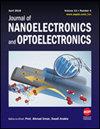掺锆氧化镍薄膜的合成与增强光学特性分析
IF 0.6
4区 工程技术
Q4 ENGINEERING, ELECTRICAL & ELECTRONIC
引用次数: 0
摘要
本研究探讨了掺杂 Zr 的氧化镍薄膜(ZNO)的形成和检测。我们使用化学沉淀法制备了掺杂 Zr 的氧化镍粉末,然后使用一种称为刮刀法的技术将这些粉末成型为薄膜。我们采用了多种方法对材料进行表征,包括 X 射线衍射 (XRD)、扫描电子显微镜 (SEM)、原子力显微镜 (AFM) 和紫外光谱分析。X 射线衍射分析表明,薄膜是纯净的,只显示出普通晶体形式的氧化镍的预期峰值,没有污染迹象。原子力显微镜结果表明,这些薄膜的表面相当粗糙。此外,光学研究表明,添加 Zr 改善了 NiO 与长波长光的相互作用,而且这些掺 Zr 薄膜的能隙(2.88 eV)比普通薄膜低,这可能有利于某些应用。本文章由计算机程序翻译,如有差异,请以英文原文为准。
Synthesis and Enhanced Optical Characterization of Zirconium-Doped NiO Thin Films
This study explores the formation and examination of Zr-doped NiO thin films (ZNO). The NiO powders mixed with Zr were made using the chemical precipitation method, and then these powders were shaped into thin films using a technique called the doctor blade method. We used several methods
to characterize the materials, including X-ray diffraction (XRD), scanning electron microscopy (SEM), atomic force microscopy (AFM), and ultraviolet spectroscopy. The XRD analysis showed that the films were pure, only displaying the expected peaks for NiO in its common crystal form and no
signs of contamination. The AFM results indicated that the surface of these films was quite rough. Moreover, the optical studies revealed that adding Zr improved how NiO interacts with light at longer wavelengths, and these Zr-doped films had a lower energy gap (2.88 eV) than usual, which
could be beneficial for certain applications.
求助全文
通过发布文献求助,成功后即可免费获取论文全文。
去求助
来源期刊

Journal of Nanoelectronics and Optoelectronics
工程技术-工程:电子与电气
自引率
16.70%
发文量
48
审稿时长
12.5 months
 求助内容:
求助内容: 应助结果提醒方式:
应助结果提醒方式:


